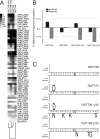Analysis of substrate specificity of Trypanosoma brucei oligosaccharyltransferases (OSTs) by functional expression of domain-swapped chimeras in yeast
- PMID: 29042445
- PMCID: PMC5724018
- DOI: 10.1074/jbc.M117.811133
Analysis of substrate specificity of Trypanosoma brucei oligosaccharyltransferases (OSTs) by functional expression of domain-swapped chimeras in yeast
Abstract
N-Linked protein glycosylation is an essential and highly conserved post-translational modification in eukaryotes. The transfer of a glycan from a lipid-linked oligosaccharide (LLO) donor to the asparagine residue of a nascent polypeptide chain is catalyzed by an oligosaccharyltransferase (OST) in the lumen of the endoplasmic reticulum (ER). Trypanosoma brucei encodes three paralogue single-protein OSTs called TbSTT3A, TbSTT3B, and TbSTT3C that can functionally complement the Saccharomyces cerevisiae OST, making it an ideal experimental system to study the fundamental properties of OST activity. We characterized the LLO and polypeptide specificity of all three TbOST isoforms and their chimeric forms in the heterologous expression host S. cerevisiae where we were able to apply yeast genetic tools and newly developed glycoproteomics methods. We demonstrated that TbSTT3A accepted LLO substrates ranging from Man5GlcNAc2 to Man7GlcNAc2 In contrast, TbSTT3B required more complex precursors ranging from Man6GlcNAc2 to Glc3Man9GlcNAc2 structures, and TbSTT3C did not display any LLO preference. Sequence differences between the isoforms cluster in three distinct regions. We have swapped the individual regions between different OST proteins and identified region 2 to influence the specificity toward the LLO and region 1 to influence polypeptide substrate specificity. These results provide a basis to further investigate the molecular mechanisms and contribution of single amino acids in OST interaction with its substrates.
Keywords: N-linked glycosylation; Trypanosoma brucei; glycosylation occupancy analysis; lipid-linked oligosaccharide specificity; oligosaccharide; oligosaccharyltransferase; yeast.
© 2017 by The American Society for Biochemistry and Molecular Biology, Inc.
Conflict of interest statement
The authors declare that they have no conflicts of interest with the contents of this article
Figures





References
-
- Lowe J. B., and Marth J. D. (2003) A genetic approach to mammalian glycan function. Annu. Rev. Biochem. 72, 643–691 - PubMed
-
- Helenius A., and Aebi M. (2004) Roles of N-linked glycans in the endoplasmic reticulum. Annu. Rev. Biochem. 73, 1019–1049 - PubMed
-
- Burda P., and Aebi M. (1999) The dolichol pathway of N-linked glycosylation. Biochim. Biophys. Acta 1426, 239–257 - PubMed
-
- Yan Q., and Lennarz W. J. (2002) Studies on the function of oligosaccharyl transferase subunits. Stt3p is directly involved in the glycosylation process. J. Biol. Chem. 277, 47692–47700 - PubMed
MeSH terms
Substances
LinkOut - more resources
Full Text Sources
Other Literature Sources
Molecular Biology Databases

